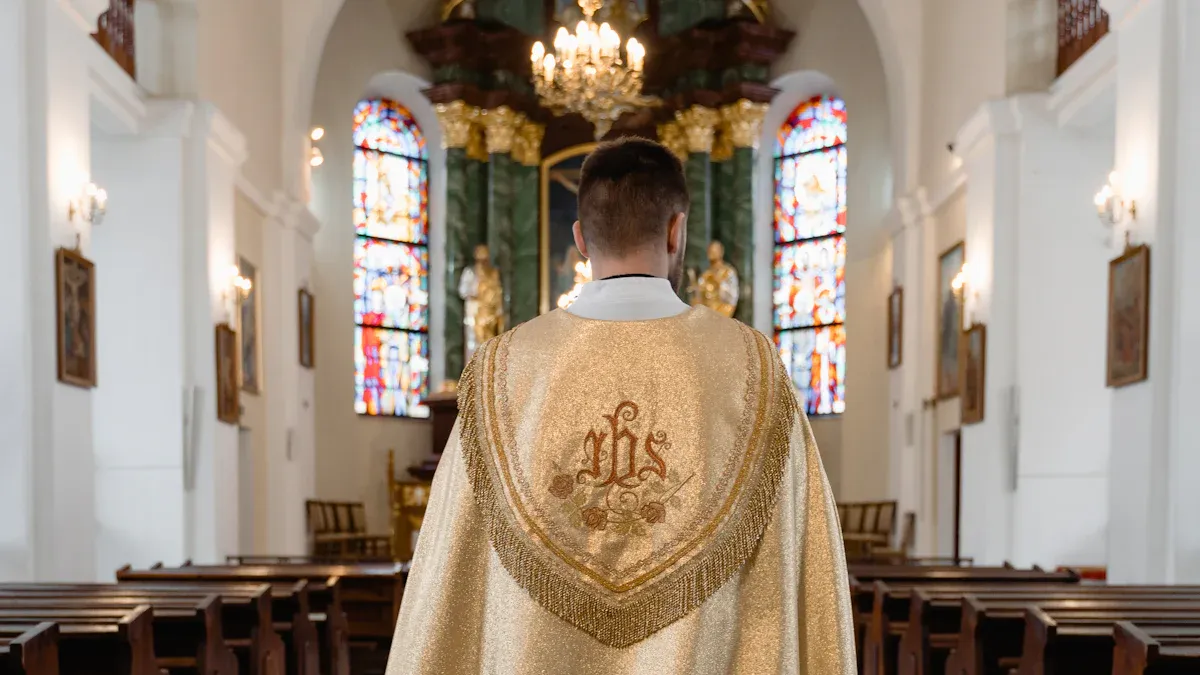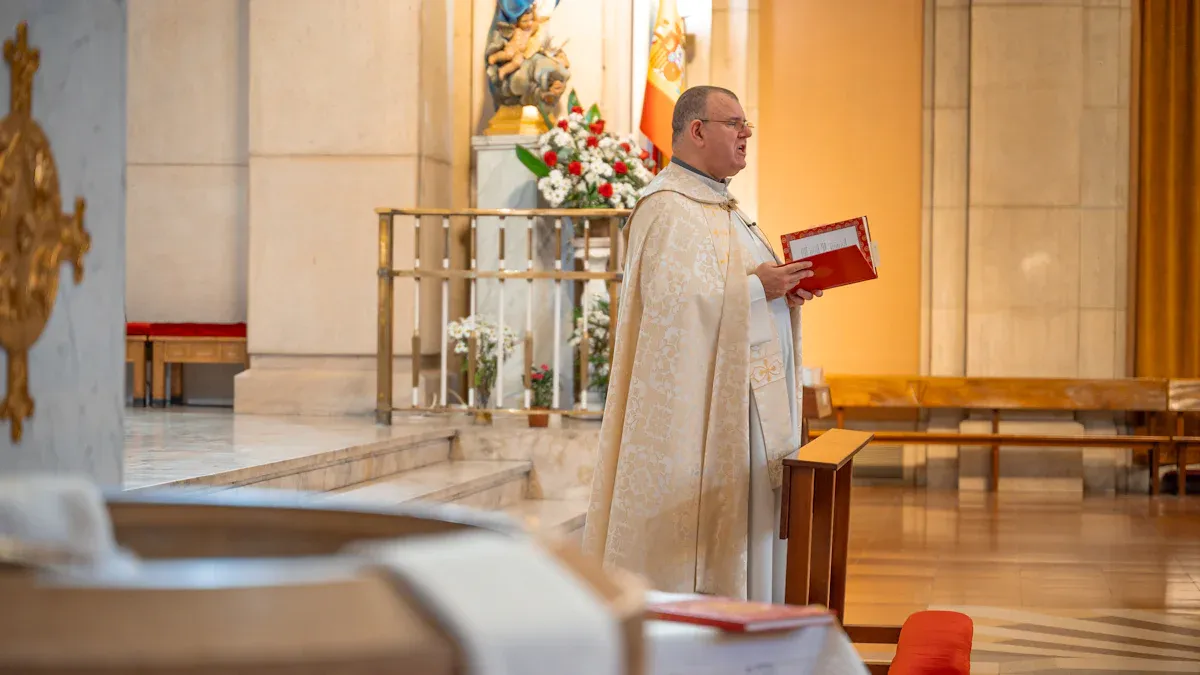
Burning of incense is important in Catholic worship. It shows prayers going to heaven, cleansing, and making things holy. Using incense makes a special feeling that touches your senses. This helps you feel closer to God. Research says using smells like frankincense helps people focus and feel respect. Many traditions use scents to clean spaces and make worship better. Catholic churches follow this practice, using incense to connect earth and heaven, bringing you nearer to God.
Key Takeaways
Incense shows prayers going up to God, reminding you of your bond with Him during worship.
Burning incense cleans and blesses the church, priest, and people, making the place feel sacred and special.
The special smell of incense makes worship better, helping you concentrate and feel nearer to God.
Incense has been used for a long time in many cultures and religions, tying today’s Catholic practices to old traditions.
Taking part in incense rituals links you to years of worship, making your spiritual experience deeper.
Historical and Biblical Roots of Incense

Ancient Religious Practices
People have used incense in worship for thousands of years. Ancient groups like Egyptians, Greeks, and Mesopotamians burned it for their gods. They also used it to clean holy places. Studies, like those in Sensing Divinity, show incense linked earth to heaven. The Pyramid Texts, old religious writings, mention burning incense to talk to gods. In Mesopotamia, incense stood for purity and was used in prayers and sacrifices. These traditions made incense a sign of holiness and respect.
Incense in Jewish Worship
In Jewish faith, incense had deep meaning. The Bible talks about its use in the Tabernacle and Temple. The Book of Exodus says priests burned Ketoret, a special mix, during sacrifices. This mix had stacte, onycha, galbanum, and frankincense. The smoke showed prayers going up to God, connecting people to Him. History also shows noble Jews used incense to honor guests and clean spaces after meals. These acts show incense was important in both worship and daily life.
Aspect | Details |
|---|---|
Biblical Reference | Exodus 30:7-9 says incense was burned daily during sacrifices. |
Ingredients for Incense | The mix included storax-gum, shell operculum, gum from narthex, and frankincense. |
Significance in Worship | Incense offerings were holy, with strict rules for use. Breaking these rules, like in II Chronicles 26:16, had serious results. |
Early Christian Use of Incense
Early Christians avoided incense because of its link to pagan rituals. From the 2nd to 6th centuries, they rejected it in sacrifices to stand apart from other religions. Later, incense became part of Christian worship in other ways. The Liturgy of St. James and St. Mark, old Christian texts, mention incense often. These writings show it as a symbol of prayers rising to God. By the Middle Ages, incense was fully part of Catholic worship. It made ceremonies feel more holy and tied believers to old traditions.
Symbolism of Incense in Catholic Churches
Prayers Going Up to Heaven
Incense shows prayers going up to God. The smoke rising during worship reminds you of this. It helps you picture your prayers reaching heaven. The Bible talks about this idea. Psalm 141 says, “Let my prayer come like incense before you.” In Revelation, incense is called the prayers of saints rising to God. This image helps you feel closer to God during worship.
Monsignor Romano Guardini calls incense a “beautiful rite.” He says the smoke shows love and worship. Father John Paul Mary Zeller adds, “Incense shows our prayers rising to God.” These ideas explain the deep meaning of this practice.
Cleaning and Making Things Holy
Incense is also used to clean and make things holy. During Mass, it blesses the priest, people, and offerings. This act shows cleaning your heart and soul for God. The Bible mentions this in Psalm 140:2 and Revelation 8:3. Incense stands for respect and prayer. By joining this ritual, you follow a tradition of cleaning and making holy all who worship.
At offertory, incense blesses the bread and wine. This shows they are becoming holy gifts. It reminds you the Eucharist is sacred. It also shows the need to approach it with a clean heart.
Making the Church Feel Special
Incense makes the church feel holy. Its smell and smoke create a special mood. This helps you focus on God. In the Old Testament, God told Moses to use incense in the Tabernacle. This showed God’s presence. Catholic churches still use incense to connect earth and heaven.
Incense was first used in worship in Egypt around 2400 B.C.
In the Bible, God told Moses how to use incense (Exodus 30:1-10).
Today, incense in church creates respect and wonder.
The smoke shows prayers going to heaven. The smell comforts you and brings you closer to God. Revelation 8:3-4 says, “The smoke of the incense rose with the prayers of the saints from the hand of the Angel before God.
Use of Incense in Catholic Ceremonies

Entrance Procession
Incense is used at the start of Mass. It helps create a holy mood. This practice comes from early Christian traditions. Here are some facts:
Tertullian wrote about church processions in the 2nd century.
By the 6th century, Eucharistic processions were common.
After Christianity became official, public processions grew popular.
In the 4th century, Jerusalem had many processions.
St. Basil and St. Ambrose mentioned hymns and prayers in processions.
Gregory of Tours described processions with relics during hard times.
These examples show incense has always made worship feel sacred.
Gospel Proclamation
Incense is sometimes used when the Gospel is read. It shows respect for Christ’s words. Church rules say using incense here is optional:
Details | |
|---|---|
Entrance Procession | Optional |
Incensing the Altar | Optional |
Proclamation of the Gospel | Optional |
Preparation of the Gifts | Optional |
Showing of the Eucharistic Bread and Chalice | Optional |
The smoke rising reminds you of God’s presence. It also makes the Gospel reading feel special.
Offertory and Eucharistic Prayer
Incense during the offertory and Eucharistic prayer has meaning. It shows prayers going to God. The bread and wine are incensed as holy gifts. This connects worship to old traditions:
Context | Description |
|---|---|
Old Testament | |
Gospel Proclamation | Incense before the Gospel shows the holiness of Christ’s words. |
Offertory | Bread and wine are incensed as offerings to God. |
Elevation | Incense is used when the Eucharist is raised, showing respect for the Sacrament. |
Incense makes rituals feel holy. It ties modern worship to ancient practices. This enriches your experience during Mass.
Funerals and Special Ceremonies
Incense is important in Catholic funerals and special events. It shows respect for the sacred and comforts people. At a Catholic funeral, the priest uses incense to honor the dead. The smoke rising stands for prayers for the soul’s journey to heaven. This brings peace and hope to those attending.
Incense is also used in other big religious events. It adds meaning to the Eucharist, Solemn Vespers, and other celebrations. These rituals show the link between earth and heaven. The smell and sight of the smoke help you think about the ceremony’s spiritual meaning.
History and church traditions show incense is widely used:
Incense is key in funerals, showing respect for the dead.
It is part of the Eucharist and Solemn Vespers to mark their importance.
Churches like Eastern Orthodox, Anglican, and Lutheran use incense often.
Using incense in these events ties you to old traditions. It reminds you of life’s sacredness and the hope of eternal peace. The smell and smoke make these moments feel deeper and more special.
Spiritual Benefits of Incense in Worship
Engaging the Senses
Incense helps involve your senses during worship. Its unique smell creates a special feeling. This scent makes the space feel holy and peaceful. Burning herbs and wood, like in Buddhist temples, helps people focus. It keeps your mind calm and present during prayer. Studies on Ottoman mosques show certain smells help create a meditative mood. This improves your emotional and spiritual connection to God.
When you walk into a Catholic church, the incense smell tells you it’s a sacred place. This smell not only uses your sense of smell but also helps you feel part of the rituals happening around you.
Deepening Connection to the Divine
Incense helps you feel closer to God by showing a link between heaven and earth. The rising smoke looks like prayers going up to God. This reminds you of the special bond between people and God. The Hebrew Bible talks about sweet-smelling offerings as “pleasing odors” to Yahweh. These offerings were a way to honor God and invite Him into worship.
In Catholic churches, incense strengthens this connection by tying worship to old traditions. Incensing the altar, Eucharist, or people shows these things are holy. It invites you to join in a shared spiritual experience.
Enhancing the Sacredness of Worship
Incense makes worship feel more sacred by involving all your senses. It marks the space as holy and different from everyday life. The smell and sight of incense create respect and focus on God. In history, incense was used in worship and linked to Bible teachings and church customs.
Incense means more than just its smell. It stands for purity and eternal life, reminding you of God’s everlasting nature. By taking part in rituals with incense, you join a tradition that has lasted for centuries. This connects you to the deep history of Catholic worship.
“Using incense in worship is more than a ritual. It helps involve your senses, brings you closer to God, and makes the moment feel holy.
Incense is very important in Catholic worship. It shows your prayers going to heaven, cleans your soul, and brings God’s presence. This practice comes from old traditions shared by many cultures and religions:
In China, incense is used in Buddhist, Confucian, and Daoist rituals.
Himalayan people burn incense to connect with the spiritual world.
Families burn incense at home altars to honor ancestors.
The smell of incense helps you feel respect and stay focused. It connects earth to heaven, bringing you closer to God in a special way.
FAQ
Why do Catholic churches use incense in worship?
Incense stands for prayers going up to heaven. It also shows cleansing and making things holy. The smell creates a special mood, helping you focus on God. This practice connects today’s worship to old traditions.
What does the smoke from incense mean?
The smoke rising shows your prayers reaching God. It reminds you of the link between earth and heaven. This picture helps you feel closer to God during worship.
Tip: Watch the smoke and think about your prayers going to God.
Is incense used in every Catholic Mass?
No, incense is not always used in Mass. It is mostly used for special events like funerals, feast days, or big celebrations. It makes these moments feel more holy.
What kind of incense is used in Catholic churches?
Churches often use a mix of frankincense, myrrh, and other scents. These smells help create respect and focus during worship.
Ingredient | Meaning |
|---|---|
Frankincense | Godliness and prayer |
Myrrh | Sacrifice and healing |
Can incense help you feel better during worship?
Yes, some incense, like frankincense, can help you relax. It may make you feel calm and focused, improving your prayer time.
Note: If you have allergies, tell your church so they can help you stay comfortable.


